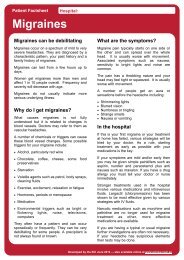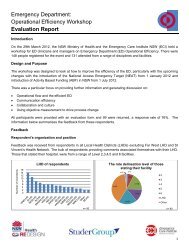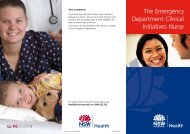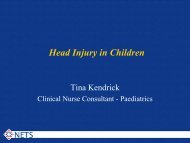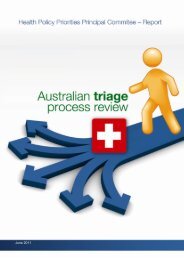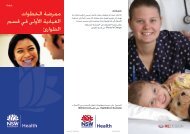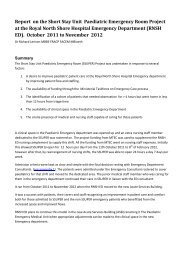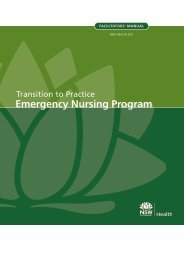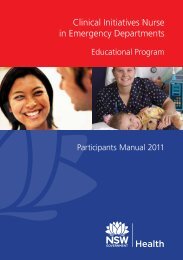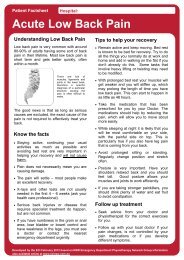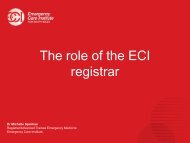Emergency Department Models of Care 2012 - NSW Health
Emergency Department Models of Care 2012 - NSW Health
Emergency Department Models of Care 2012 - NSW Health
- No tags were found...
Create successful ePaper yourself
Turn your PDF publications into a flip-book with our unique Google optimized e-Paper software.
Why use the model?Key principlesBenefits <strong>of</strong> the modelThe ED SSU model has been developed to provide a short period <strong>of</strong> assessment, course <strong>of</strong>therapy or observations for a group <strong>of</strong> patients who no longer require ED care. In the pastthese patients would have remained in an ED or been admitted to an inpatient unit.These units are designed to provide short-term (< 24 hours) assessment and/or therapy forselect conditions in order to streamline the episode <strong>of</strong> care. ED SSU front-loads resources toprovide an intensive period <strong>of</strong> evaluation, treatment and supervision. The ultimate aim is toimprove patient care, and improve flow through ED, thereby improving ED bed access andreducing inpatient LOS for these patients.The EDSSU is designed for patients who require hospital treatment, observation and/orfurther assessment but are not likely to require a hospital stay <strong>of</strong> more than 24 hours. Itprovides:■■■■■■■Improved patient flow for the ED to increase its capacity, reduce patient length <strong>of</strong> stayand assist in reducing long ambulance <strong>of</strong>f-load timesA more comfortable environment for patients than the EDA safety net function against inappropriate discharge.A shorter LOS for this patient group than would occur with inpatient admission to ahospital ward.Key functions <strong>of</strong> an EDSSU are:- Observation- Specialist assessment and diagnosis- Short-term high-level management <strong>of</strong> patient conditionsEDSSUs are not:- Temporary ED overflow areas- Used to keep patients that are awaiting an inpatient bed- Overflow areas for other specialty servicesED SSU must:- Be separate from the ED bed base- Be managed by the ED Director (or a delegate who is an emergency medicine specialist).Successful Australian models have emphasised an emergency physician in charge;however, joint management with a consultant from another specialty (if applicable) hasbeen described elsewhere.- Have dedicated medical and nursing staff with ED experience available 24 hours a day- Have defined number beds with clinical services (oxygen, suction, patient ablutionfacilities)- Have specific admission and discharge criteria and policies.EDSSU allows the ED and hospital to function more efficiently by:■■■■■Increasing ED patient turnoverReducing ED LOS for medical patientsImproving patient flow through the EDFacilitating timely ambulance <strong>of</strong>f loadIncreasing the overall hospital bed capacity which saves hospital bed days.<strong>Models</strong> <strong>of</strong> <strong>Emergency</strong> <strong>Care</strong> <strong>NSW</strong> HEALTH PAGE 41




